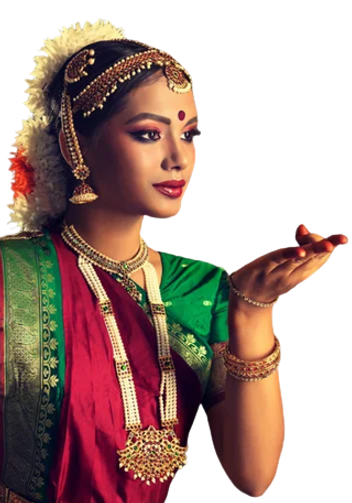 germany flag |
|---|
 india |
 Image by Kelly Sikkema |

Know about the Indian Classical Dance styles
Odissi
A sculpture in motion, or a moment frozen in dance?

Odissi is considered the oldest Indian classical dance form of India. Odisha has ample evidence in the temple sculptures to support this statement.
A sculpture from the 2nd century during the reign of King Kharavel carved in the Udaygiri caves shows a Sabha with a dancer, musicians and audience, which implies the prevalence of dance and music in this region.
The connection between Odissi and temple sculptures is quite apparent, specially because of the thrice-deflected posture, TRIBHANGI which is a characteristic feature of this dance form.

In the development stage of this beautiful dance form, the Odissi Gurus took inspiration from the temple panels and included most of the postures in the choreographies.
Thus, we see many Darpan Sundari poses (women holding mirrors), Alasyakanya poses (women idling with half-closed eyes) and poses with musical instruments such as Veena, Mardala (the percussion instrument for Odiss), Flute and Manjira.
The term Kathak is derived from the words "Katha" i.e "story", and "Kathakar", "the one who tells a story".
Kathak dancers tell various stories through their hand movements, footwork, body movements, flexibility, and their facial expressions. Kathak is famous for the choreographies narrating the childhood stories of the Hindu god Krishna. It was predominantly performed in the courts of north Indian kingdoms.
The earliest surviving text with Kathak roots is the Natya Shastra attributed to sage Bharatamuni.
With the entry of the Mughals in India, Kathak underwent a rapid change. Manuscripts, music, jewellery, costumes and techniques of dance evolved and underwent rapid changes. Urdu language was introduced into the art form.
During the British era, the artists were forced to continue practising Kathak secretly as the British Government had forbidden dance as an art form. Thus emerged the concept of 'Gharanas', which are- Lucknow, Jaipur and Benares forms in Kathak.
All the three Gharanas have their own unique style and built their own repertoire which is now being passed on through the "Guru-Shishya Parampara", i.e.
the teacher-disciple tradition of Indian culture.


©Kishor_Gumaste
Narrating stories with a mesmerizing rhythm
Kathak
Bharatnatyam
A spellbinding combination of
Bhava, Raga, Tala and Natyam
Earlier, the Devadasis danced in temples as an offering to the temple deity. The saint bards composed several compositions, and dancing was a regular practice. It was considered to be prestigious and respectable, and Devadasis were patronized by the Rulers who ruled the region.
All Southern India kings patronized the art forms and supported their growth. Earlier known as Kuttu, Adal, Natyam, Dasiattam, Bharatam, Natyamu or Cinnamelam, the Sadir dance form got established gradually in Tanjavur from the 9th to the 19th century.
One of the most famous classical styles- Bharatanatyam developed
in south India (in and around Tanjavur).

©Navia_Natarajan

During this time, Bharatnatyam was formulated and systematized by the Tanjore Quartet brothers.
However, the British government banned the Devadasi system once it seized power. Devadasis and their holy art of dancing had to suffer a dark, hoary phase.
After the Indian Independence, great thinkers and scholars like Rukhmini Devi, E. Krishna Iyer, Dr. V. Raghavan, Prof. Sambhamoorthy worked for this dance form's reform and development. It named as “Bharatanatyam”. The immense contribution of some great Nattuvanars, dance Gurus and performers has helped Bharatanatyam to change, develop and refine in form and content.



